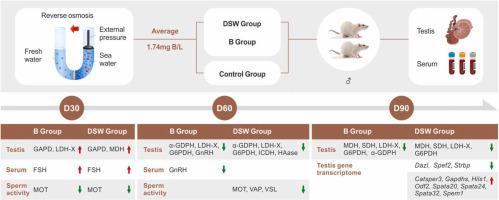Effects of desalinated seawater with excessive boron on reproductive health of male rats
引用次数: 0
Abstract
To investigated the effects of desalinated seawater with excessive boron on reproduction of male rats Rats exposed to desalinated seawater (DSW), equivalent boron (B) water, and deionized water (control group) in a 90-days experiment. We explored sperm toxicity, testicular toxicity, and differential gene expression by detecting sperm quality, testicular enzyme activity, and transcriptome, and finally conducted fertility experiments. Results showed the sperm activity-motility (MOT) decreased and follicle-stimulating hormone (FSH) increased in both DSW and B groups at 30 days. As testicular enzymes, malate dehydrogenase (MDH) and lactate dehydrogenase isoenzyme-X (LDH-X) increased in DSW group, and 3-phosphoglyceraldehyde dehydrogenase (GAPD) increased in both DSW and B groups at 30 days. α-glycerol phosphate dehydrogenase (α-GDPH), sorbitol dehydrogenase (SDH), glucose-6-phosphate dehydrogenase (G6PDH), MDH and LDH-X in DSW and B groups decreased at 90 days. Transcriptome analysis revealing the downregulated genes (Dazl, Spef2 and Strbp) and upregulated genes (Catsper3, Gapdhs, Hils1, Odf2, Spata20, Spata24, Spata32 and Spem1) associated with male reproductive processes in 90-days DSW group. Our findings suggest that 30 days (short-term) exposure to DSW might decrease MOT by affecting energy metabolism. FSH and GAPD might be sensitive early biomarkers. 90 days (long-term) and low-dose exposure to DSW may cause spermatogenesis-related genetic changes.

过量硼淡化海水对雄性大鼠生殖健康的影响
研究过量硼淡化海水对雄性大鼠生殖能力的影响。在为期90天的实验中,大鼠分别暴露于淡化海水(DSW)、等量硼(B)水和去离子水(对照组)中。我们通过检测精子质量、睾丸酶活性和转录组来探索精子毒性、睾丸毒性和差异基因表达,最后进行生育实验。结果显示,DSW和B组在30 d时精子活力(MOT)降低,促卵泡激素(FSH)升高。随着睾丸酶的增加,DSW组苹果酸脱氢酶(MDH)和乳酸脱氢酶同工酶- x (LDH-X)升高,DSW组和B组3-磷酸甘油醛脱氢酶(GAPD)升高。DSW和B组α-甘油磷酸脱氢酶(α-GDPH)、山梨醇脱氢酶(SDH)、葡萄糖-6-磷酸脱氢酶(G6PDH)、MDH和LDH-X均在90 d时降低。转录组分析揭示了90天DSW组中与雄性生殖过程相关的下调基因(Dazl、Spef2和Strbp)和上调基因(Catsper3、Gapdhs、Hils1、Odf2、Spata20、Spata24、Spata32和Spem1)。我们的研究结果表明,30天(短期)暴露于DSW可能通过影响能量代谢来降低MOT。FSH和GAPD可能是敏感的早期生物标志物。90天(长期)和低剂量暴露于DSW可能导致与精子发生相关的遗传变化。
本文章由计算机程序翻译,如有差异,请以英文原文为准。
求助全文
约1分钟内获得全文
求助全文

 求助内容:
求助内容: 应助结果提醒方式:
应助结果提醒方式:


